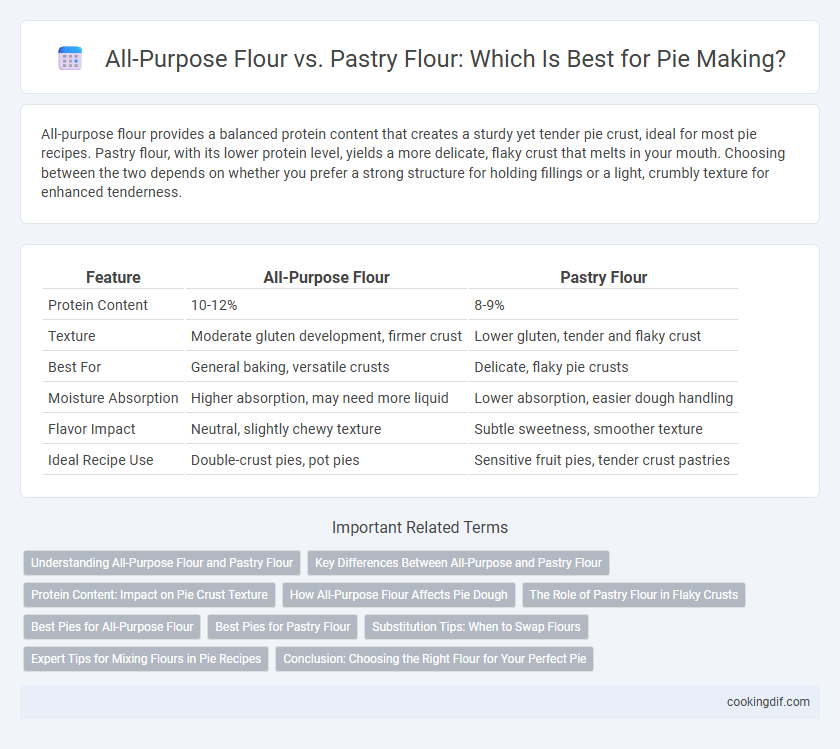All-purpose flour provides a balanced protein content that creates a sturdy yet tender pie crust, ideal for most pie recipes. Pastry flour, with its lower protein level, yields a more delicate, flaky crust that melts in your mouth. Choosing between the two depends on whether you prefer a strong structure for holding fillings or a light, crumbly texture for enhanced tenderness.
Table of Comparison
| Feature | All-Purpose Flour | Pastry Flour |
|---|---|---|
| Protein Content | 10-12% | 8-9% |
| Texture | Moderate gluten development, firmer crust | Lower gluten, tender and flaky crust |
| Best For | General baking, versatile crusts | Delicate, flaky pie crusts |
| Moisture Absorption | Higher absorption, may need more liquid | Lower absorption, easier dough handling |
| Flavor Impact | Neutral, slightly chewy texture | Subtle sweetness, smoother texture |
| Ideal Recipe Use | Double-crust pies, pot pies | Sensitive fruit pies, tender crust pastries |
Understanding All-Purpose Flour and Pastry Flour
All-purpose flour contains a moderate protein content, typically around 10-12%, making it versatile for various pie crusts by providing a balance between tenderness and structure. Pastry flour has a lower protein content, about 7-9%, which results in a finer, softer texture ideal for delicate, flaky pie crusts. Understanding the protein levels in these flours helps bakers choose the right flour to achieve desired pie crust texture and crumb.
Key Differences Between All-Purpose and Pastry Flour
All-purpose flour contains higher protein content, typically around 10-12%, resulting in more gluten development and a firmer pie crust, while pastry flour has lower protein, about 7-9%, producing a tender and flaky texture ideal for delicate pie crusts. The finer milling of pastry flour enhances tenderness and crumb structure, making it preferable for pies requiring a softer bite. Using all-purpose flour yields a sturdier crust suitable for fruit pies, whereas pastry flour excels in cream or custard pies where a light, crisp crust is desired.
Protein Content: Impact on Pie Crust Texture
All-purpose flour typically contains 10-12% protein, which provides a balance of gluten development ideal for a sturdy yet tender pie crust. Pastry flour has a lower protein content, around 7-9%, resulting in less gluten formation and a softer, flakier crust texture. Choosing pastry flour enhances tenderness in delicate pie crusts, while all-purpose flour yields a more structured, slightly chewier finished product.
How All-Purpose Flour Affects Pie Dough
All-purpose flour creates a sturdier pie dough due to its higher protein content, resulting in more gluten formation that provides structure and chewiness. This flour yields a pie crust that is slightly tougher but holds fillings well without becoming soggy. Using all-purpose flour can enhance the pie's durability, especially for fruit pies with moist fillings.
The Role of Pastry Flour in Flaky Crusts
Pastry flour has a lower protein content, typically around 8-9%, compared to all-purpose flour's 10-12%, which results in less gluten formation and a more tender, flaky pie crust. The finer texture of pastry flour absorbs fat more effectively, creating delicate layers that contribute to flakiness. Using pastry flour in pie dough enhances moisture retention and yields a crust that balances both softness and crispness, making it ideal for pastries requiring a tender bite.
Best Pies for All-Purpose Flour
All-purpose flour creates a balanced gluten structure ideal for flaky and sturdy pie crusts, making it the best choice for classic fruit pies like apple, cherry, and blueberry. Its moderate protein content (typically 10-12%) provides enough elasticity for rolling without toughness, ensuring perfect texture in custard and pumpkin pies as well. For pies requiring a tender but resilient crust, all-purpose flour outperforms pastry flour, which is better suited for softer, more delicate baked goods.
Best Pies for Pastry Flour
Pastry flour's lower protein content, typically around 8-9%, creates a tender, flaky crust ideal for delicate pies like fruit tarts and custard pies. Its finely milled texture absorbs less water, resulting in a softer dough that enhances the subtle sweetness and smooth filling of cream pies and berry pies. Using pastry flour over all-purpose flour prevents toughness and promotes a melt-in-the-mouth quality favored in classic pies such as apple, cherry, and pumpkin.
Substitution Tips: When to Swap Flours
When making pie, all-purpose flour can substitute pastry flour if you aim for a slightly denser, sturdier crust instead of a tender, flaky one. Use a mixture of all-purpose flour with a small amount of cornstarch or cake flour to mimic the lower protein content of pastry flour for improved texture. Adjust the fat content or chilling time to maintain the desired flakiness when swapping flours.
Expert Tips for Mixing Flours in Pie Recipes
Expert tips for mixing all-purpose flour and pastry flour in pie recipes highlight balancing protein content to achieve optimal crust texture. Combining 50% all-purpose flour, which has higher gluten, with 50% pastry flour, rich in starch, creates a tender yet flaky crust. Adjusting the ratio based on humidity and desired crust crispness ensures consistent results in pie crusts.
Conclusion: Choosing the Right Flour for Your Perfect Pie
Choosing the right flour for pie making depends on the desired texture and flakiness of the crust. All-purpose flour offers a balanced protein content, resulting in a sturdy yet tender crust, while pastry flour, with its lower protein level, produces a more delicate and crumbly texture ideal for light, flaky pies. For a perfectly textured pie crust, consider pastry flour to achieve tenderness or all-purpose flour for a slightly firmer structure.
All-purpose flour vs pastry flour for pie making Infographic

 cookingdif.com
cookingdif.com